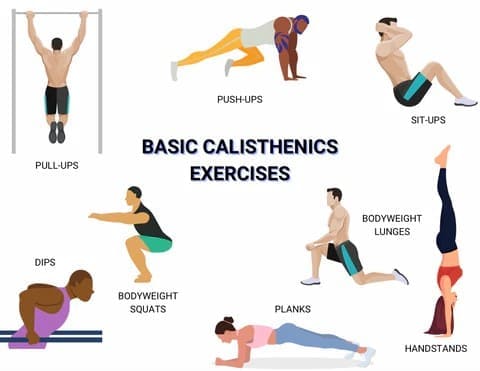Basic Calisthenics Exercises: Benefits, Drawbacks, and Muscles Worked

Calisthenics is a powerful and accessible form of training that builds strength, endurance, and flexibility using only body weight. The following exercises are fundamental to calisthenics and help develop different muscle groups. This guide explores the pros and cons of each, what muscles they work, and how to perform them correctly.
1. Pull-Ups
Pros:
✔ Builds upper body and grip strength
✔ Engages multiple muscles (back, arms, core)
✔ Can be progressed with weighted pull-ups
Cons:
✘ Difficult for beginners
✘ Requires a pull-up bar
✘ Can cause strain if done with poor form
Muscles Worked:
- Latissimus dorsi (lats)
- Biceps
- Forearms
- Core
How to Do It:
- Grip the pull-up bar with palms facing forward, hands shoulder-width apart.
- Hang with arms fully extended.
- Pull yourself up until your chin clears the bar.
- Lower slowly to the starting position.
2. Push-Ups
Pros:
✔ No equipment needed
✔ Strengthens chest, shoulders, and triceps
✔ Can be modified for difficulty
Cons:
✘ Can be hard for beginners
✘ Requires proper form to avoid wrist/shoulder strain
✘ Progression is limited compared to weighted training
Muscles Worked:
- Chest (pectorals)
- Shoulders (deltoids)
- Triceps
- Core
How to Do It:
- Get into a plank position with hands slightly wider than shoulders.
- Lower your body until your chest nearly touches the ground.
- Push back up to the starting position.
3. Sit-Ups
Pros:
✔ Strengthens core and abdominal muscles
✔ Improves posture and stability
✔ Can be done anywhere
Cons:
✘ Can strain the lower back
✘ Not as effective as other core exercises like planks
✘ Requires proper form to avoid neck strain
Muscles Worked:
- Rectus abdominis
- Hip flexors
- Obliques
How to Do It:
- Lie on your back with knees bent and feet flat.
- Cross arms over your chest or place hands behind your head.
- Lift your upper body towards your knees.
- Lower back down slowly.
4. Dips
Pros:
✔ Strengthens triceps, chest, and shoulders
✔ Can be done on parallel bars or a sturdy surface
✔ Effective for upper body pushing strength
Cons:
✘ Requires bars or a bench
✘ Can cause shoulder strain if not done correctly
✘ Challenging for beginners
Muscles Worked:
- Triceps
- Chest
- Shoulders
How to Do It:
- Grip parallel bars or place hands on a sturdy surface.
- Lower your body until elbows form a 90-degree angle.
- Push back up to the starting position.
5. Bodyweight Squats
Pros:
✔ Strengthens lower body and core
✔ No equipment needed
✔ Improves mobility and balance
Cons:
✘ Less resistance compared to weighted squats
✘ Can lead to knee strain if done incorrectly
✘ Not as effective for muscle growth as weighted squats
Muscles Worked:
- Quadriceps
- Hamstrings
- Glutes
- Core
How to Do It:
- Stand with feet shoulder-width apart.
- Lower your hips until thighs are parallel to the ground.
- Push through your heels to return to standing.
6. Planks
Pros:
✔ Strengthens the entire core
✔ Improves posture and stability
✔ Low impact and safe for most people
Cons:
✘ Can be difficult to maintain for beginners
✘ Does not directly build muscle mass
✘ Requires endurance and patience
Muscles Worked:
- Core (abs and obliques)
- Lower back
- Shoulders
How to Do It:
- Get into a forearm or full plank position.
- Keep your body in a straight line from head to heels.
- Hold for as long as possible while maintaining good form.
7. Bodyweight Lunges
Pros:
✔ Improves leg strength and balance
✔ Can be done anywhere
✔ Works on single-leg strength
Cons:
✘ Can cause knee strain if done improperly
✘ May be difficult for beginners with poor balance
✘ Less resistance compared to weighted lunges
Muscles Worked:
- Quadriceps
- Glutes
- Hamstrings
How to Do It:
- Step forward with one leg and lower your hips.
- Keep your knee at a 90-degree angle.
- Push back up to the starting position.
8. Handstand
Pros:
✔ Develops shoulder and core strength
✔ Improves balance and coordination
✔ Enhances body control
Cons:
✘ Difficult for beginners
✘ Requires wrist strength and mobility
✘ Risk of falling if not done safely
Muscles Worked:
- Shoulders
- Core
- Arms
How to Do It:
- Start with a wall-assisted handstand.
- Kick up into a handstand position.
- Engage your core and maintain balance.
- Hold for as long as possible.
Conclusion
Calisthenics offers an effective, equipment-free way to build strength, endurance, and flexibility. Each exercise has unique benefits and challenges, making it essential to focus on proper form and gradual progression. Whether you're a beginner or advanced athlete, these bodyweight movements can help you achieve a well-rounded fitness level.
Would you like a workout plan incorporating these exercises? Let me know! ??
Post Created: February 11, 2025, 8:28 am
Post Updated: February 11, 2025, 8:30 am
If this post gave you valuable insights or helped you in any way, consider supporting me! Your contribution allows me to continue producing helpful, high-quality content that everyone can benefit from. It’s thanks to supporters like you that I can keep sharing my passion and expanding this community. ❤️
